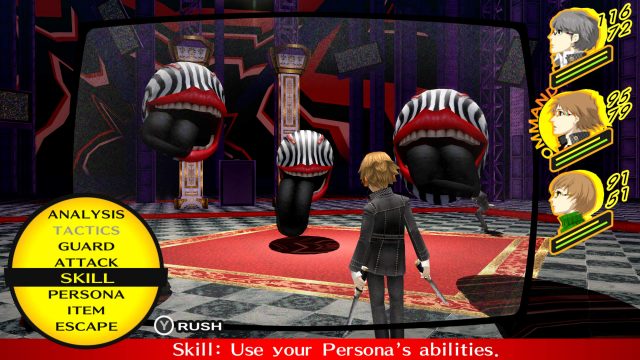Persona 4 Golden PS4 Review
Spending My Time, Watching the Days Go By
As hordes of dedicated fans will tell you, Persona 4 is a stone-cold classic of the RPG genre. This series holds a very special place in the hearts of so many that it may come as a shock that even now, in 2023, there are still some of us who’ve never experienced a single game in Atlus’ franchise. I suppose that makes me the perfect target demographic for the newly released PlayStation 4 version of Persona 4 Golden, a game that’s been such a well-known quantity for over a decade already. While this latest offering sports nothing new over its previous releases, the question arises whether this entry is a worthwhile experience for newcomers. The answer is a definite yes, though the game’s substantial acclimation curve is one that shouldn’t be underestimated; those going in without the right expectations may quickly become alienated.
Persona 4 treads some novel ground due to being a murder mystery, something not often covered in JRPGs. The game takes place in the fictional sleepy little town of Inaba where nothing much of note happens. Nothing, that is, until transfer student Yu Narukami (whom players can actually name whatever they like) arrives and a series of grisly murders breaks out soon after. People suddenly disappear without a trace, only to be found again days later, with their bodies grotesquely displayed. To heighten the mystery, Yu discovers that visions of the victims appear on the Midnight Channel, a seemingly supernatural program that airs after days of rain shroud the nocturnal town in a dense blanket of fog. What’s more, Yu discovers he is actually able to enter the TV and cross into a parallel dimension, letting him track down and rescue the abducted victims before they, too, die.
Yu isn’t alone on his search for the Inaba killer and is soon joined by several other students from the local high school he attends, most of whom have been kidnapped to the TV dimension themselves before being rescued by the group and joining forces with them. Persona 4‘s group of protagonists, including the light-hearted goofball Yosuke, the more reserved Yukiko, former idol Rise, and scrappy Chie turns out to be one of its main strengths, given tons of characterization and story beats, and brought to life by an outstanding cast of voiceover artists. Between the budding friendships, fleshed-out personalities, meaty story, and possible romances, players are sure to feel deepening connections with individual members of the group, and a real sense of sadness when the adventure ultimately reaches its end.
The time Yu and the others have to solve the case is established early and set in stone. The game takes place over the course of a year, following an actual day-to-day calendar, from April 2011 to April 2012. Each day is broken up into three main sections: school is in session in the mornings, outside of holidays and weekends; afternoons can be spent on extracurricular activities, including clubs and sports, exploring a dungeon, or loitering around town; and evenings are available for socializing with friends, spending time with family, or working at a part-time job. There are dozens of things to do, many of which offer benefits like incremental stat or relationship bonuses, but it is also an overwhelming virtual checklist of activities that almost begs for a guide to be made the most of. There’s a certain sense of accomplishment as Yu becomes more capable as a result of his efforts, but repeating this process day-in and day-out for a full year is, at least initially, a tall and intimidating order for new players.
Chief on the list of daily activities, of course, are the Persona series’ iconic Social Links. Yu can build up his relationship with the other party members, as well as a host of other townspeople in and around Inaba, by choosing to spend an afternoon with them. This may advance that particular Social Link level, and occasionally even grant battle bonuses for Yu’s fellow combatants, but each one also uses up an entire afternoon or evening of available time. There are twenty-four Social Links available to chip away at, and each one can be leveled up ten times. However, Social Links are only available on certain days or during certain conditions, and can only be advanced once Yu has built up enough relationship points with an individual. The whole system provides constant minute hits of dopamine, but can also be a bit of a timesink.
While Persona 4‘s narrative and character development are excellent, those qualities are in shorter supply during Social Link scenes. Each Social Link does tell a side story as it rises towards its max level, but these are generally far less interesting than the main plot, with only a few standing out as memorable; a particular standout is delving into the backstory of Yu’s uncle Dojima and his daughter Nanako, and learning of the family tragedy that has caused their bond to become strained. The Social Links do include the occasional diamond in the rough, but the highest praise goes solely to the numerous and lengthy main narrative sections. Where many days can be whiled away chasing Social Links and the like, the game frequently wrests control away from the player for its main story beats. Contrary to what one might expect, these are not necessarily always to further the murder mystery plot, but can simply be slices of Inaba life. School trips, festival days, the gang heading to the beach to bid farewell to their summer break; the year is littered with character-building sections like these, when life is sweet and the cast simply leans back and breathes a collective sigh of relaxation. Of course, the hunt for the serial killer is woven in throughout, and the drama and suspense ratchet up accordingly for the game’s final act. While daily life can be a grind, which is realistic in its own way, these story chunks can easily go an hour or more at a time, and ensure that effective storytelling is never shorted.
The lengthy periods of exposition are helped by the fact that the game’s voice acting — generally only found in these scenes — is of high quality almost all-round. The cast includes well-known names like Troy Baker, Laura Bailey, and the like. However, with such solid performances, the character of Chie stands out negatively due to being performed with an unnecessarily loud intensity even when it seems ill-fitting to the moment, and Teddie’s combat voiceovers are no more than a near-constant stream of repetitive phrases shouted out, seemingly every other turn or so. Music is a similarly oddly mixed bag. Across the board, tracks are extremely well-written and catchy, but many feel out of place given the sleepy town setting, or otherwise suffer from the game’s long runtime (easily 80 hours plus) by simply becoming far too repetitive; this is further exacerbated by the frequent use of music with lyrics, which then becomes played out and grating even faster.

Enemy designs can be bizarre, making them far more interesting than the actual dungeons they are found within.
Incidentally, most of Persona 4‘s ambitious storytelling happens without a single enemy encounter to break it up; combat is instead reserved for the dungeon segments, which occur exclusively within the TV world. While attempting to rescue the killer’s targets once they’ve appeared on the Midnight Channel, Yu and his friends must overcome scores of enemies, called Shadows, en route to the dungeon boss. In addition to providing valuable item drops and new Persona cards, winning a battle under certain conditions also triggers the Shuffle Time mini-game, in which the party can earn even greater rewards and buffs. Shadows feature creative designs, albeit with quite a few palette swaps, and are best overcome by preying on their elemental weaknesses. Enemies may be weak, or even immune, to any of seven damage types, including elemental affinities. However, this makes every brand new enemy encounter essentially a guessing game until the correct weakness has been determined.
In order to capitalize on these enemy weaknesses, Yu and his friends have various attacks at their disposal, granted to them by their Personas. A Persona is a physical manifestation of the strength of each character’s soul, and available to them in battle once they’ve accepted their inner selves. Each character has a Persona that roughly corresponds to a certain element or battle strategy (Yukiko excels at healing abilities, for example), while Yu can equip multiple Personas, with new ones frequently found during dungeon exploration, and swap between them freely in battle. This makes for a useful stop-gap since it is nearly impossible to have all elemental bases covered at all times. In an odd bit of game balancing, combat grows considerably easier as the game progresses. Far more elemental and tactical options begin to open up as new party members are recruited, whereas early-game battles see the smaller party grasping at straws when trying to hit enemy weaknesses. A late-game party, by contrast, will often be able to steamroll enemy encounters, frequently chaining together attacks in rapid succession, while also benefitting from buffs a start-up party couldn’t even dream of, such as auto-regenerating HP after each battle.
While the combat system itself is fun, the dungeons in which battle takes place are anything but. Each dungeon has a general theme based around the mind of the person occupying it, but beyond a general aesthetic like “bathhouse” or “night club”, there are zero interesting ideas or concepts at play within them. The vast majority of floors are randomly generated, a bland bunch of corridors and rooms that offer nothing of note other than being stuffed full of enemy encounters, some treasure chests, and one or two bosses along the way. Worse, dungeons are long, generally consisting of ten or more floors apiece, and this can make for an unwelcome time away from the main narrative. The game’s sidequests, shallow and dry at the best of times, can also require return trips to its dungeons to farm items, but those that sacrifice the time to grind will be rewarded with levels and items drops that can be sold in town to unlock far better weapons and armor. Luckily, players can tackle dungeons when they see fit, even splitting them up over several in-game days; as long as each one is completed, and its occupant rescued, by a certain deadline, the game can continue.
Despite being essentially the same game that was first released over a decade ago, Persona 4 Golden manages to avoid feeling dated to this day. A great cast of characters, an intriguing murder mystery story, and satisfying storytelling that moves at an unhurried pace are all completed by fun combat mechanics to preserve the game’s high standard. Even as the Golden iteration added some new content to it, these core sentiments remain largely unchanged. With a handful of exceptions, the majority of Social Links and sidequests underwhelm, while dungeons can be lengthy chores and the day-by-day calendar system makes completing all the behind-the-scenes checklists unnecessarily stressful, but though these annoyances require some getting used to, the game ultimately remains as much worth playing today as ever. The PlayStation 4 release may not bring anything new to the table, but those who’ve never experienced the game before will find a filling and satisfying meal awaits.
Disclosure: This review is based on a free copy of the game provided by the publisher.


Excellent main narrative that really takes its time
Sterling focus on developing a likeable cast of main characters
Voicework is full of standout performances
Competent, solid combat system
Dungeons are lengthy and boring timesinks
Music gets oh so very repetitive
Sidequests feel like tacked-on annoyances
If I never have to listen to Teddie's combat commands again, it'll still be too soon










I honestly dont know how this does not get a 5 out of 5 : ( . The review sounds like someone not a fan of the series or is new to it. I mean hey 4 is still ok but the battles were great music was never ever repetitive cause it was so well done. I do agree with teddy even though I love him. I think you really got this one wrong but thanks for the review.
Alas, I went into this one knowing that a 4 out of 5 (the lowest I think we’ve ever rated this game) was not going to sit well with some. But even in your quick bullet points, there’s very little we disagree on:
It doesn’t just “sound” like someone new to the series wrote it, but it’s stated right in the intro. We agree on the battles being fun, the music is very well done, and teddie sounds obnoxious. We only seem to differ in our definition of the word “repetitive”. It’s just that these perceived shortcomings (and a few others I listed) made more of a difference to me than you, it seems.
WE do not agree but thank you for writing the review. Not everyone view things the same i guarantee if you ask people their top 5 rpgs not many will have the same top 5 : ). persona 4 is not even in my top 5 def 10 . I just think giving it an 80 out of 100 or 4-5 is too small for a masterpiece. : ) once again thank you for doing the review .